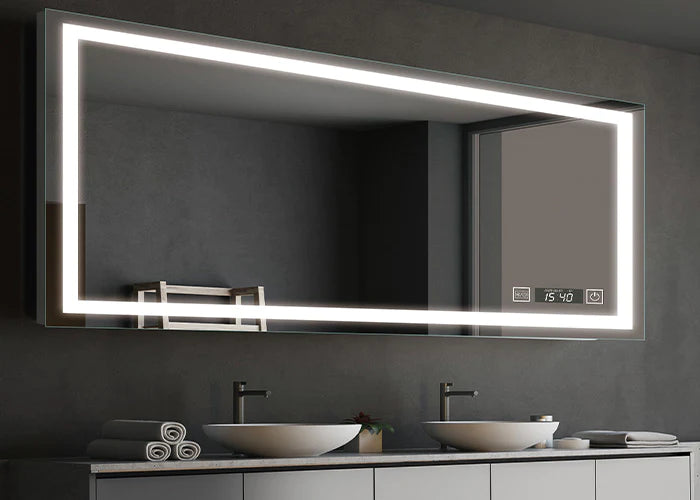The majority of people have seen flickering light bulbs. Whether it's a ballast issue or an electric filament that's going to burn out, the only way out is to replace the problematic bulb or component. Even so, the issue is slightly more complicated with LED lights.
LED lights, despite their incredible efficiency and supposedly infinite longevity, do flicker on occasion, just like any other lighting system. While they don't flicker as often as others, we will go over why they do and what you should do about it.
3 Kinds of Scenes When Your LED Lights Flicker

Image source: Shutterstock
Home Lighting
In home lighting applications, flickering LED lights can be particularly bothersome in areas such as the living room or bedroom where people often spend a lot of time. Constant flickering can be distracting, cause eye strain, and even make it difficult to sleep. Additionally, in homes that employ smart-home systems or other advanced lighting setups, flickering LEDs may interfere with some of the more complex features of these systems, leading to further issues. Therefore, homeowners may have to troubleshoot and fix the issue to ensure maximum comfort and functionality of their lighting system.
Automotive Lighting
Flickering LED lights in automotive lighting applications, such as lights installed on cars, trucks or motorcycles, may be a sign of a faulty electrical system. These types of flickers often occur when there is a loose connection, a malfunctioning alternator, or a defective battery. As a result, they can be detrimental to the vehicle's performance and could even lead to more dangerous issues, such as a loss of power or a dead battery, making it essential to address the problem as soon as possible.
Outdoor Displays
Outdoor displays that incorporate LED lighting, such as billboards and large screens, can also experience flickering. This is because LED lights are often used in large quantities in these applications to create vivid and dynamic visual experiences. However, flickers can be distracting, hinder the quality of the display, and even lead to malfunctions over time. To fix this, the display owner may have to contact a professional to inspect the display and determine the cause of the flickering, which may require modifying the power source, replacing the LED modules, or adjusting the settings in the control system.
9 Possible Reasons Why Your Home LED Lights Flicker + Solutions

Image source: Shutterstock
Nothing turns a room from beautiful to horrible faster than a flickering light bulb. It's one of those problems that you want to have fixed right away, so here's a quick breakdown of the possible causes of your LED problem.
Problematic Bulbs
This is the most typical explanation for flickering lights. When the bulb is screwed in too firmly, the filament can break, causing flickering. If this is the case, simply replacing the old lightbulb with a fresh one would suffice.
Incompatible Bulbs
When using LED lamps, certain appliances may not function properly. If you're employing LED bulbs and the fixture flickers, switch to a standard incandescent bulb. This appears to be a common issue when using lighting switches that also incorporate a dimmer controller.
Incompatible Dimmer Switches
LED lights are not compatible with traditional dimmer switches, causing flickering in some instances. To avoid this, use compatible dimmer switches with LED bulbs that are rated to work with them. If the LED mirror is controlled by a dimmer switch, be sure to use one that is compatible with LED lighting to avoid flickering.
Low-quality LED Bulbs
Low-cost LED bulbs may result in flickering, so it's beneficial to use high-quality ones. High-quality LED bulbs often come with features, including power surge protection or built-in heat sinks, that can help prevent flickering and ensure optimal operation.
Wiring Issues
This problem is especially common in older homes. The wires might become detached from their connections over time. Such a problem is also more likely if you just had electrical repairs done in your home by a technician who did not securely connect all of the cables.
Malfunctioning Fixtures
It is hard to deny that the light fixtures in your home will eventually get old, broken, and rusted. This will nonetheless result in flickering light bulbs.
To test this, remove the flickering bulb and replace it with a working one. If the flickering persists, it could be your light fixture. If the flickering persists after you change the fixture, have a professional inspect the wiring.
Large Appliances
If you see any brief flickering, consider if anything else is going on in your home. When huge appliances are turned on, lights may briefly flicker.
For example, check to see whether anyone is using a corded vacuum cleaner. Light flicker caused by starting intense appliances or other tools is usually not a cause for concern.
Circuit Overload
LED lights can sometimes flicker when an electrical circuit is drawing too many amps. If your kitchen lights go away when you use your toaster, it is possible that your toaster is too enormous for the circuit it is connected to.
Call a licensed electrician for assistance with this one. To see what comes about, try plugging the troublesome equipment into different outlets. If you notice flickering no matter what location you are in the house, it may be time to replace the appliance.
Wattage Surge
Electrical wattage can have an impact on the operation of your LED lights, especially if you use low-cost drivers. If your LED lights are linked to devices in the same circuit that consumes high power demands, the more efficient drivers regulate the output of the LEDs, causing the lights to flicker.
Are Flickering LED Lights Dangerous?

Image source: Shutterstock
When working with electrical components and troubleshooting, safety is of the utmost importance. As a result, when you see your LED lighting begins to flicker, you'll know it's time to take the necessary steps. While flickering lights are not always dangerous, if the problem is not handled, a few potential risks may arise.
Fire
If a loose connection triggers the flickering, sparks could fly and start a fire. Furthermore, a problem with the power source could result in an electrical surge, which might lead to a fire.
Electric Shocks
An electrical arc could form if an unsecured link causes flickering. If you touch the light, you will receive an electric jolt. Furthermore, if the electrical current ignites something else in the house, this could result in a fire.
Health Problems Associated with LED Flicker

Image source: Shutterstock
Flickering LED lights can have negative impacts on our health, potentially causing various health problems.
Headaches and Migraines
For people who are susceptible to it, flickering light can trigger migraines or worsen the symptoms.
Visual Discomfort and Reduced Performance
Flickering can cause visual discomfort, blurred vision, and reduced visual task performance, which can be especially problematic in workplaces or other environments that require sustained visual attention.
Fatigue and Cognitive Impairment
Flickering LED lights can cause mental fatigue and a decrease in cognitive functioning. The beams from flickering lights can scatter and cause glare, which can make working or studying difficult, affect learning, and decrease productivity.
Motion Sickness and Vertigo
Some people might experience motion sickness or vertigo as a result of flickering LED lights.
How Can I Stop and Prevent Flickering LED Lights in the Future?

Image source: Shutterstock
The simplest way to avoid the dangers of flickering LED lights is to ensure that your LED lights are properly fitted. So, before you do anything else, twist the LED bulb to make sure it's not just a loose bulb causing all of this trouble.
Check the bulbs as well to see if they have to be replaced. If they do, swap them out for new ones.
Another component to look into is the power source. If there is something wrong with the power source, you should call an electrician to have it serviced. They'll be able to figure out what's causing the flickering and make whatever repairs are needed.
Takeaway
When it comes to LED lights, a few factors may cause them to flicker. Aside from the aforementioned causes, blinking LED lights might also indicate that something is seriously wrong.
Checking the current cannot be overstated because an overwhelmed circuit can endanger the wiring in your house. In this case, contacting a professional is critical since poor wiring or a faulty circuit breaker is detrimental to your home.





